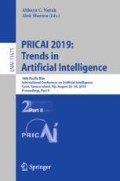Abstract
We model and study the problem of assigning traffic in an urban road network infrastructure. In our model, each driver submits their intended destination and is assigned a route to follow that minimizes the social cost (i.e., travel distance of all the drivers). We assume drivers are strategic and try to manipulate the system (i.e., misreport their intended destination and/or deviate from the assigned route) if they can reduce their travel distance by doing so. Such strategic behavior is highly undesirable as it can lead to an overall suboptimal traffic assignment and cause congestion. To alleviate this problem, we develop moneyless mechanisms that are resilient to manipulation by the agents and offer provable approximation guarantees on the social cost obtained by the solution. We then empirically test the mechanisms studied in the paper, showing that they can be effectively used in practice in order to compute manipulation resistant traffic allocations.
Access this chapter
Tax calculation will be finalised at checkout
Purchases are for personal use only
Notes
- 1.
Restricting origins/destinations of journeys to road junctions is without loss of generality since fictitious nodes that serve the sole purpose of acting as starting/ending point of a journey can always be created by edge splitting operations.
- 2.
Sometimes also referred to as dynamic flow in the literature. We prefer the term flow over time as the adjective dynamic has often been used in many algorithmic settings to refer to problems where the input data arrive online or change over time. We assume that all the agents are present at time \(t=0\) and the network is cleared after the last agent reaches their destination.
- 3.
We do not prevent agents from using edges other than the ones belonging to their assigned paths, as doing so would result in a waste of public resources (i.e., road capacity). To avoid congestion, though, we assume that agents not following their assigned route can be disincentivized from using an edge that, according to the scheduled traffic, is filled to capacity. This can be easily implemented in a smart traffic control system through the use of traffic cameras that check cars’ number plates.
- 4.
A graph is K-edge-connected if it remains connected when strictly fewer than K edges are removed.
References
9th DIMACS Implementation Challenge - Shortest Paths (1999). http://www.diag.uniroma1.it/challenge9/download.shtml
Beckmann, M., McGuire, C., Winsten, C.B.: Studies in the economics of transportation. Technical report (1956)
Bogomolnaia, A., Deb, R., Ehlers, L.: Strategy-proof assignment on the full preference domain. J. Econ. Theor. 123(2), 161–186 (2005). https://doi.org/10.1016/j.jet.2004.05.004
Brenner, J., Schäfer, G.: Online cooperative cost sharing. In: Calamoneri, T., Diaz, J. (eds.) CIAC 2010. LNCS, vol. 6078, pp. 252–263. Springer, Heidelberg (2010). https://doi.org/10.1007/978-3-642-13073-1_23
Caragiannis, I., Filos-Ratsikas, A., Frederiksen, S.K., Hansen, K.A., Tan, Z.: Truthful facility assignment with resource augmentation: an exact analysis of serial dictatorship. In: WINE 2016, pp. 236–250 (2016)
Conitzer, V., Sandholm, T.: Failures of the VCG mechanism in combinatorial auctions and exchanges. In: AAMAS 2006, pp. 521–528. ACM (2006)
Coogan, S., Arcak, M.: A compartmental model for traffic networks and its dynamical behavior. IEEE Trans. Autom. Control 60(10), 2698–2703 (2015)
Daganzo, C.F.: The cell transmission model: a dynamic representation of highway traffic consistent with the hydrodynamic theory. Transp. Res. Part B: Methodol. 28(4), 269–287 (1994)
Djahel, S., Salehie, M., Tal, I., Jamshidi, P.: Adaptive traffic management for secure and efficient emergency services in smart cities. In: PERCOM 2013, pp. 340–343. IEEE (2013)
Filos-Ratsikas, A., Frederiksen, S.K.S., Zhang, J.: Social welfare in one-sided matchings: random priority and beyond. In: SAGT 2014, pp. 1–12 (2014)
Ford, L.R., Fulkerson, D.R.: Constructing maximal dynamic flows from static flows. Oper. Res. 6(3), 419–433 (1958). https://doi.org/10.1287/opre.6.3.419
Ford, L.R., Fulkerson, D.R.: Flows in Networks. Princeton University Press, Princeton (1962). http://www.jstor.org/stable/j.ctt183q0b4
Goodwin, P.: The economic costs of road traffic congestion (2004)
Krzyzanowski, M., Kuna-Dibbert, B., Schneider, J.: Health effects of transport-related air pollution. WHO Regional Office Europe, pp. 1–190 (2005)
Leontiadis, I., Marfia, G., Mack, D., Pau, G., Mascolo, C., Gerla, M.: On the effectiveness of an opportunistic traffic management system for vehicular networks. IEEE Trans. Intell. Transp. Syst. 12(4), 1537–1548 (2011)
Levin, M.W., Fritz, H., Boyles, S.D.: On optimizing reservation-based intersection controls. IEEE Trans. Intell. Transp. Syst. 18(3), 505–515 (2017)
Nesterov, Y., de Palma, A.: Stationary dynamic solutions in congested transportation networks: summary and perspectives. Netw. Spat. Econ. 3(3), 371–395 (2003). https://doi.org/10.1023/A:1025350419398
Nissim, K., Smorodinsky, R., Tennenholtz, M.: Approximately optimal mechanism design via differential privacy. In: ITCS 2012, pp. 203–213 (2012)
Osorio, C., Nanduri, K.: Urban transportation emissions mitigation: coupling high-resolution vehicular emissions and traffic models for traffic signal optimization. Transp. Res. Part B: Methodol. 81, 520–538 (2015)
Procaccia, A.D., Tennenholtz, M.: Approximate mechanism design without money. ACM TEAC 1(4), 18:1–18:26 (2013). https://doi.org/10.1145/2542174.2542175
Raphael, J., Maskell, S., Sklar, E.: From goods to traffic: first steps toward an auction-based traffic signal controller. In: Demazeau, Y., Decker, K.S., Bajo Pérez, J., de la Prieta, F. (eds.) PAAMS 2015. LNCS (LNAI), vol. 9086, pp. 187–198. Springer, Cham (2015). https://doi.org/10.1007/978-3-319-18944-4_16
Skabardonis, A., Dowling, R.: Improved speed-flow relationships for planning applications. Transp. Res. Rec.: J. Transp. Res. Board 1572, 18–23 (1997)
Stansfeld, S.A., Matheson, M.P.: Noise pollution: non-auditory effects on health. Oxf. J. Med. Health Br. Med. Bull. 68(1), 243–257 (2003)
Svensson, L.G.: Strategy-proof allocation of indivisible goods. Soc. Choice Welfare 16(4), 557–567 (1999). https://doi.org/10.1007/s003550050160
Vasirani, M., Ossowski, S.: A market-inspired approach for intersection management in urban road traffic networks. JAIR 43, 621–659 (2012)
Author information
Authors and Affiliations
Corresponding author
Editor information
Editors and Affiliations
Rights and permissions
Copyright information
© 2019 Springer Nature Switzerland AG
About this paper
Cite this paper
Serafino, P., Ventre, C., Tran-Thanh, L., Zhang, J., An, B., Jennings, N. (2019). Social Cost Guarantees in Smart Route Guidance. In: Nayak, A., Sharma, A. (eds) PRICAI 2019: Trends in Artificial Intelligence. PRICAI 2019. Lecture Notes in Computer Science(), vol 11671. Springer, Cham. https://doi.org/10.1007/978-3-030-29911-8_37
Download citation
DOI: https://doi.org/10.1007/978-3-030-29911-8_37
Published:
Publisher Name: Springer, Cham
Print ISBN: 978-3-030-29910-1
Online ISBN: 978-3-030-29911-8
eBook Packages: Computer ScienceComputer Science (R0)

